Splendid killifish - Aphyosemion splendopleure
Scientific name: Aphyosemion splendopleure
Common name: Splendid killifish
Family: Nothobranchiidae
Usual size in fish tanks: 5 - 6 cm (1.97 - 2.36 inch)
014
Recommended pH range: 6.7 - 7.3
Recommended water hardness: 7 - 15°N (125 - 267.86ppm)
0°C 32°F30°C 86°F
Recommended temperature range: 23 - 25 °C (73.4 - 77°F)
The way how these fish reproduce: Spawning
Where the species comes from: Africa
Temperament to its own species: peaceful
Temperament toward other fish species: peaceful
Usual place in the tank: Middle levels
Origin
The Splendid Killifish (Aphyosemion splendopleure) originates from the freshwater waterways of Cameroon in Africa. These fish inhabit slow-moving streams, ponds, and densely vegetated areas, where the water is soft to moderately hard with a slightly acidic to neutral pH. Their natural habitat is often shaded, with an abundance of plants and leaf litter that provides shelter and breeding sites.
Lifespan
With proper care, Splendid Killifish can live between 3 to 5 years in an aquarium. To maximize their lifespan, provide them with a well-maintained environment, stable water parameters, and a balanced diet.
Short Description
Splendid Killifish are a peaceful and visually striking species, known for their vibrant colors and intricate patterns on their fins. Males are especially colorful, featuring elongated fins with spots and a yellow border that they use to display during courtship and territorial behavior. They typically reach a size of 5-6 cm (1.97-2.36 inches) in captivity, making them suitable for small to medium-sized aquariums. These fish prefer to be kept in pairs or small groups, where their calm nature can shine. Regular partial water changes and a well-planted tank will keep them thriving and healthy.
General Care Tips
Splendid Killifish are relatively easy to care for, provided their specific water conditions are met. They prefer a water temperature between 23-25°C (73.4-77°F) and a pH range of 6.7-7.3. The water hardness should be maintained between 7-15°N (125-267.86 ppm) to mimic their natural habitat. Since they inhabit shaded environments in the wild, it's advisable to use dim lighting in the aquarium, which can be achieved with floating plants like Lemna minor or Water Lettuce.
These fish are middle-level swimmers and prefer a tank setup with plenty of plants, including Java Moss or Anubias, which offer both cover and potential spawning sites. An aquarium of at least 40 liters (10 gallons) is recommended for a pair or small group. Regular partial water changes of 20-30% weekly are crucial for maintaining high water quality, as Splendid Killifish are sensitive to poor water conditions.
Food and Feeding
Splendid Killifish can be somewhat picky eaters, so offering a varied diet is essential. They generally accept high-quality flake foods or small granules, but they thrive when supplemented with live or frozen foods. Feed them bloodworms, grindal worms, and blackworms to mimic their natural diet and keep them in optimal health. Providing live or frozen food 2-3 times a week will enhance their coloration and support their overall well-being. Always ensure that the food particles are appropriately sized to fit into their small mouths.
Sexing
Sexing Splendid Killifish is relatively easy. Males are more vibrant and have elongated fins covered in intricate spots with a distinct yellow border. They use these vibrant fins to display to females and other males during courtship or territorial disputes. In contrast, females are more subdued in coloration and have shorter, less ornate fins.
Breeding
Breeding Splendid Killifish in an aquarium is relatively straightforward. Set up a separate breeding tank with plenty of spawning sites, such as Java Moss or spawning mops, for the female to deposit eggs. Keep the water parameters similar to their main tank, with a temperature between 23-25°C (73.4-77°F) and a pH around 6.7-7.0.
After spawning, remove the medium (spawning mop or Java Moss) containing the eggs and place it in a container lined with a layer of moist peat. Once the fry's eyes become visible inside the eggs, transfer them back into water to trigger hatching. The fry can be fed on newly hatched brine shrimp or infusoria once they become free-swimming. Proper water quality in the breeding tank is essential to ensure a high survival rate for the fry.
Conclusion
The Splendid Killifish is a stunning and peaceful species that can be a delightful addition to a well-maintained aquarium. With their vibrant colors, calm demeanor, and interesting breeding behaviors, they bring life and intrigue to any aquatic environment. By providing a stable habitat with plenty of plants, offering a varied diet, and maintaining excellent water quality, these killifish can thrive and even breed successfully in captivity.
Pictures
Bought by aqua-fish.net from jjphoto.dk.
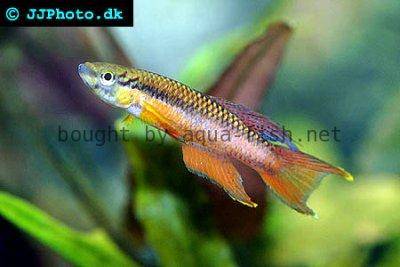







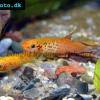 Lyretail
Lyretail  Redchin
Redchin  Panchax
Panchax 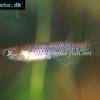 Sixbar
Sixbar  Amiets
Amiets  Blue
Blue  Blue
Blue 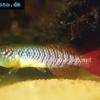 Guenthers
Guenthers 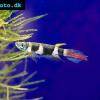 Banded
Banded